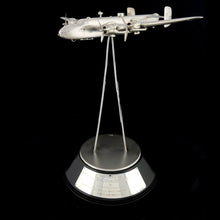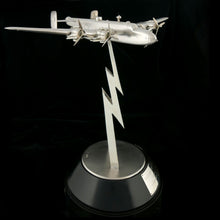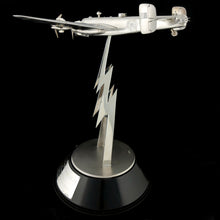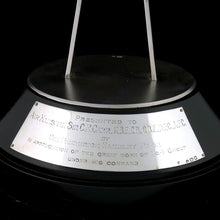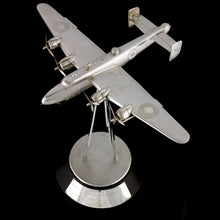Second World War Halifax Bomber Manufacturer’s Presentation Model, 1945
Adding product to your cart
Overall: 30cm (11.9in) x 30.5cm (12in) x 21cm (8.2in)
Silver. Modelled as an Handley Page Halifax B Mk III as it appeared its final form with extended wing tips and modified rudder, mounting navigational aids on the fuselage, machine guns in the nose cone, mid upper and rear turrets; the whole raised on a swivel lightning bolt support mounted on an ebonized base, bearing presentation plaque inscribed 'Presented to Air Marshal Sir C.R. Carr, KBE, CB, DFC, AFC / By / Sir Frederick Handley Page / in appreciation of the great work of No. 4 Group / under his command’. Maker’s mark of Goldsmiths & Silversmiths Co Ltd, 112 Regent street, London. Hallmarked London 1945.
The Handley Page Halifax four-engine heavy bomber was conceived in 1936 and entered operational service with No. 4 Group Bomber Command in March 1941. Designed to the same specifications as the ill-fated twin-engine Avro Manchester (withdrawn from service in 1942), it was greatly improved by exchanging Rolls Royce Vulture engines for Merlins.
At the start of the war Bomber Command’s older aircraft - the Fairey Battle, Bristol Blenheim, Handley Page Hampden, Armstrong Whitworth Whitley and Vickers Wellington - had all proved woefully inadequate, and had fallen easy prey to German fighters. The lack of an effective heavy bomber was compounded in August 1941 by the findings of the Butt report which revealed only three British bombs in every hundred fell within five miles of the target. This ineffectiveness worsened by heavy aircrew losses led to questions in Parliament as to whether Bomber Command itself was a viable or even necessary force.
Read more
No 4 Group’s Yorkshire based 35 and 76 Squadrons were the first to be equipped with the Mark I Halifax in late 1940. A lack of rudder response when flying at relatively low speeds caused a number of aircraft to enter into uncontrollable and fatal spins. It was thought this was induced by violent rudder action typically employed during evasive flying. Accordingly the assembly was redesigned over an extended period so that the leading edges of rudders, instead of being angled backwards above and below the tail-plane, were made vertical. The Halifax B Mk II duly appeared in October 1941, one month after Lady Halifax, performed the naming ceremony at Handley Page’s Radlett aerodrome. It quickly became a major component of Bomber Command's strategic bombing campaigns against the Axis Powers, primarily at night, under the dogged leadership of Air Marshal Arthur ‘Bomber’ Harris. Harris described the Halifax as inferior to the rival Avro Lancaster (in part due to its smaller payload) though this opinion was not shared by many of the crews that flew it, not least for the better chance the ‘Halibag’ offered of getting out in an emergency. It was officially concluded that Halifax crews had a 25 per cent chance of getting out whereas that figure was 15 per cent for Lancaster crews owing to the Lanc’s smaller hatches and closely confined interior.
Sir Frederick Handley Page CBE FRAeS (1885-1962) - Father of the Heavy Bomber - was knighted in 1942 for his contribution to the country’s effort in both the First and Second World Wars. A charismatic businessman, he invested in technical education, and was deeply committed to air safety. Between the wars he produced the HP42 airliner, the flagship of Imperial Airways, which remarkably for the time had an impeccable air safety record. He was knighted in 1942 and always made a point of making himself known to his employees from the shop floor upwards, generating great loyalty. Over 6,000 Halifaxes were built with production continuing until April 1945. During their service with Bomber Command, Halifaxes flew 82,773 operations and dropped some 225,000 tons of bombs, while 1,833 aircraft were lost. Handley Page was the uncle of the fighter ace and Guinea Pig Club founding member Wing Commander Geoffrey Page DSO, OBE, DFC*.
Air Marshal Sir Charles Roderick Carr, KBE, CB, DFC, AFC (1891 -1971) was a New Zealander, commissioned as a temporary flight sub-lieutenant in the Royal Naval Air Serviceand first seeing action as a spotter at the Battle of Loos in October 1915. In 1919, he went to Russia to fight the Bolsheviks and was awarded a Distinguished Flying Cross for an destroying four aircraft in an attack on an enemy airfield. In early 1920 he was briefly chief of the Lithuanian Air Force.In 1921 he took part in Sir Ernest Shackleton's final Antarctic expedition, and on his return was granted an RAF short service commission in the rank of Flying Officer. In 1927, he attempted a non-stop flight to India, in a modified Hawker Horsley but ran out of fuel en route, ditching in the Persian Gulf having covered 5500 km (3,420 mi), which was sufficient to set a new world distance record, but which was beaten within a few hours by Lindbergh’s solo Atlantic flight in the Spirit of St. Louis.
During the Second World War, he took over command of No.4 Group from New Zealander AVM Arthur ‘Mary’ Coningham. Carr served in Bomber Command as AOC No. 4 Group RAF for the majority of the war. In May 1942 it took part in the 1000 bomber raid on Cologne and in early 1943 made a substantial contribution in the Battle of the Ruhr, which lasted until July. Losses were heavy but the results worthwhile. By mid 1944 No 4 Group was entirely equipped with Halifaxes, for the invasion of Normandy. Carr was promoted Deputy Chief of Staff (Air) at the Supreme Headquarters of the Allied Expeditionary Force in June 1945.
Ref: Barratt, M. (2023) ‘The Greatest Escape: A Bomber Command Navigator s Story of Survival in Nazi Germany’.








